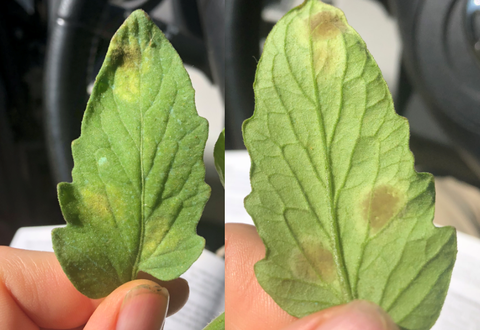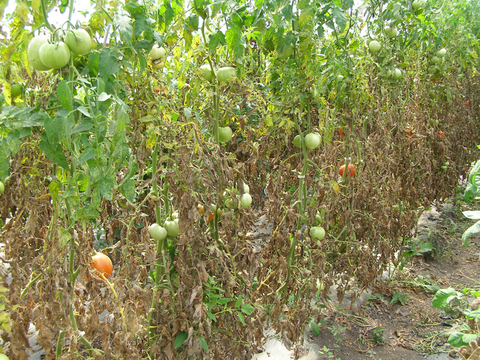Quick facts
- Tomato leaf mold is typically only an issue in greenhouse and high-tunnel tomatoes.
- The disease is driven by high relative humidity (greater than 85%).
- Foliage is often the only part of the plant directly infected. Infection will cause infected leaves to wither and die, indirectly affecting yield.
- In severe cases, blossoms and fruit can also be infected, directly reducing yield.
- Leaf mold is caused by the fungus Passalora fulva (previously called Fulvia fulva or Cladosporium fulvum).
How to tell tomato leaf mold from other issues
- The oldest leaves are infected first.
- Pale greenish-yellow spots, usually less than 1/4 inch, with no definite margins, form on the upper sides of leaves.
- Olive-green to brown velvety mold forms on the lower leaf surface below leaf spots.
- Leaf spots grow together and turn brown. Leaves wither and die but often remain attached to the plant.
- Infected blossoms turn black and fall off.
- Fruit infections start as a smooth black irregular area on the stem end of the fruit. As the disease progresses, the infected area becomes sunken, dry and leathery.
Biology
Leaf mold is caused by the fungus Passalora fulva (previously called Fulvia fulva or Cladosporium fulvum). It is not known to be pathogenic on any plant other than tomato. There are many races of P. fulva.
-
Spores of P. fulva can survive for 6 months to a year above ground at room temperature.
- It is unknown if spores will survive on the surface of stakes, tools and high tunnel walls from one season to the next in Minnesota's climate.
- The pathogen forms dark, hard resting structures within infected plant debris.
- These structures will produce an abundance of new spores when exposed to air.
- They are the most likely means for P. fulva to survive from one season to the next.
- The leaf mold pathogen can survive on and in tomato seed and may be introduced to a new area by this route.
- Spores of P. fulva can start an infection at a wide range of temperatures.
- Relative humidity at or above 85% will favor severe leaf mold epidemics, but some disease can occur at humidity less than 85 %.
- New spores form on the lower surface of infected leaves within 10 to 12 days. If humidity remains over 85%, these spores will infect new leaves.
- Within the growing season, multiple generations of the pathogen can be completed.
- It can spread from leaf to leaf and plant to plant by wind, rain/overhead irrigation, tools, workers and perhaps insects.
Managing tomato leaf mold in home gardens
Because of the high humidity requirements of tomato leaf mold, this disease is unlikely to be seen in home gardens. For a list of more likely candidates, see the Quick guide to insects and diseases of tomatoes.
Managing tomato leaf mold on farms
- Scout for tomato leaf mold during periods of high humidity (over 85%).
- Optimal temperature is between 71 °F and 75 °F, but disease can occur at temperatures as low as 50 °F and as high as 90 °F.
- The first leaf mold infections of the season have been observed in the first week of June in Minnesota high tunnel tomatoes.
- Although varieties designated as resistant to leaf mold can be found in many seed catalogs, these may or may not be effective in reducing disease in Minnesota.
- The 12 races of P. fulva make it hard to rely solely on resistant varieties for management
- Each resistant cultivar protects against only one to a few races.
- The population of P. fulva on a farm can change if new races emerge or are introduced from another area.
- Growers with a history of leaf mold are encouraged to try resistant varieties on a small scale to determine their efficacy at the location.
For a list of potential resistant varieties, visit the Cornell Disease Resistant Vegetable Varieties webpage.
- Use drip irrigation and avoid watering foliage.
- Space plants to provide good air movement between rows and individual plants.
- Stake, string or prune to increase airflow in and around the plant.
- Sterilize stakes, ties, trellises, etc. with 10% household bleach or commercial sanitizer.
- Circulate air in greenhouses or tunnels with vents and fans and by rolling up high tunnel sides to reduce humidity around plants.
- Keep night temperatures in greenhouses higher than outside temperatures to avoid dew formation on the foliage.
- Remove crop residue at the end of the season. Burn it or bury it away from tomato production areas.
- Clean the high tunnel or greenhouse walls and benches at the end of the season with a commercial sanitizer.
Applications should be made prior to infection when environmental conditions favor disease to be the most effective.
Fungicide applications should be repeated according to label instructions. It is important to alternate between different chemical families to avoid the development of pathogen resistance to particular active ingredients.
For organic growers, trials in New York have shown the copper-based product Champ gave some level of control. When using copper hydroxide for tomato leaf mold, make sure the product is labeled for organic use. Formulations with higher percentages of copper will be more effective but have an increased re-entry interval (REI / the amount of time you must wait between applying and re-entering the area for safety reasons).
For a current list of recommended products, see the Midwest Vegetable Production Guide.
Note: In Minnesota, a high tunnel is considered a greenhouse for the sake of pesticide application. Read all label instructions carefully prior to use.
- If the product label prohibits use in a greenhouse, it cannot be legally applied in a high tunnel.
- If the product label provides specific instructions for use within a greenhouse or does not mention use in a greenhouse, it can be used in a high tunnel.
- Different formulations of the same product may vary on greenhouse use.
- The instructions on the label attached to the pesticide container must be followed. The Midwest Vegetable Production Guide contains information on label language around greenhouse use.
CAUTION: Mention of a pesticide or use of a pesticide label is for educational purposes only. Always follow the pesticide label directions attached to the pesticide container you are using. Be sure that the plant you wish to treat is listed on the label of the pesticide you intend to use. And observe the number of days between pesticide application and when you can harvest your crop. Remember, the label is the law.
Reviewed in 2021




